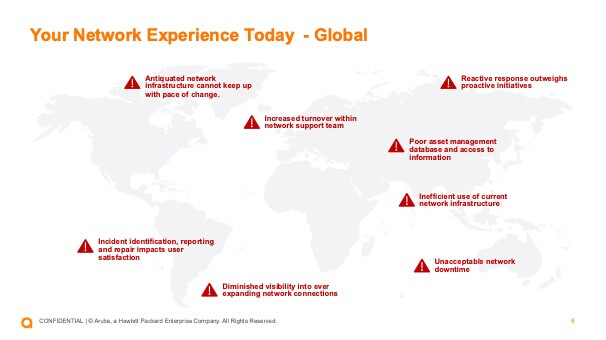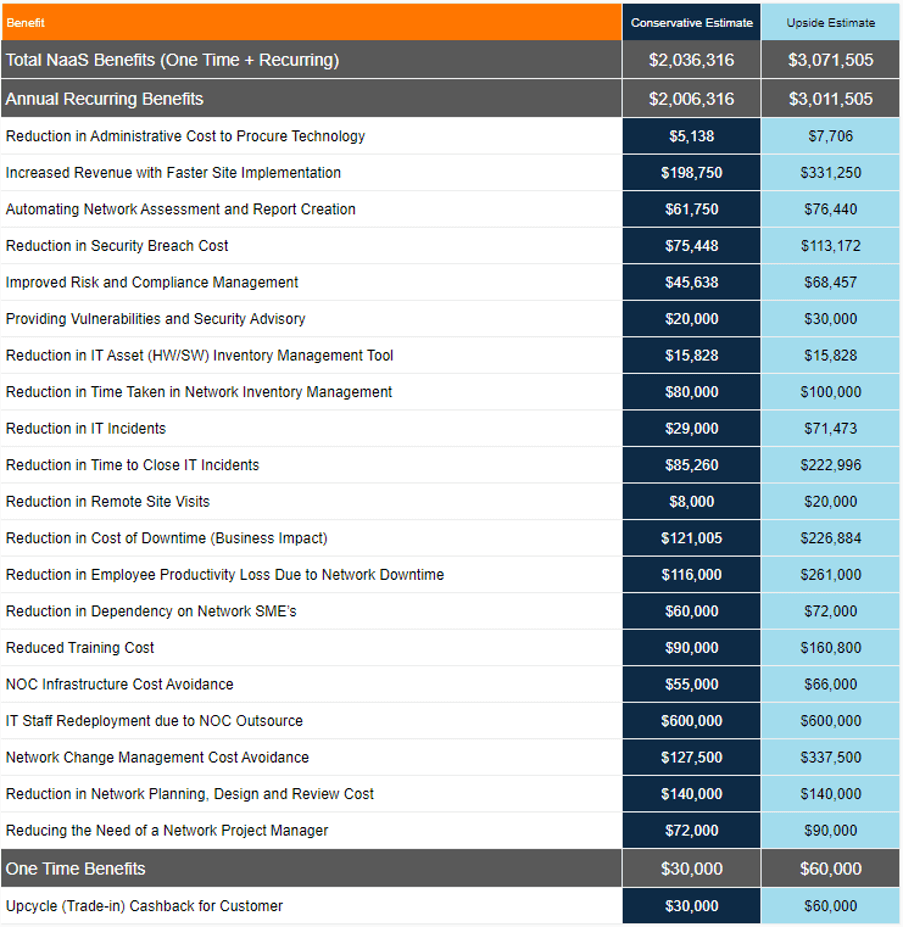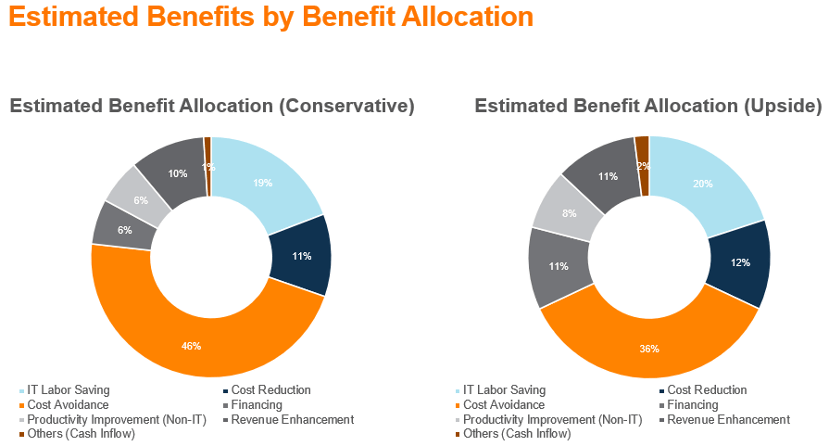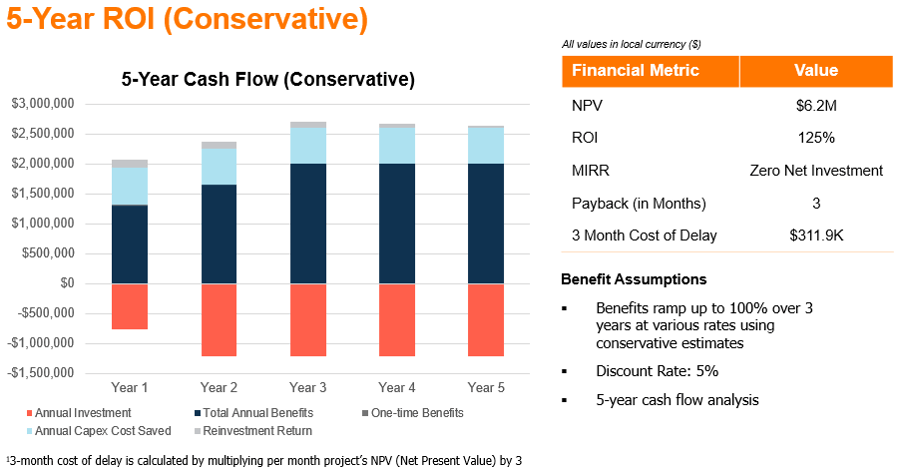
As customers evaluate new models of acquiring and utilizing technology, new ways of evaluating these acquisitions are required, along with new ways of positioning the business benefits of the proposing organizations.
As major analysts’ reports state, including Fortune Business Insights and Gartner, Network as a Service (NaaS) is a quickly emerging acquisition methodology for a customer’s network infrastructure, operations, and support needs. NaaS provides customers with a flexible, agile, and responsive environment. Using the Aruba Value Advisor (AVA) toolset, a sales team can provide customers with identifiable business benefits, categorization of those benefits, and financial quantification of those benefits to review with the prospect or customer.
To illustrate the use of AVA tool and the available content in the NaaS environment, let’s understand this with an example customer environment. This customer is a mid-sized transportation vehicle manufacturer with revenues of $5.3 billion, 50 global locations, and 5800 employees. Margins generated by this customer in 2021 approach 12.5%. For this example, the total number of network devices managed by the network is assumed to be 1500 devices, but because of IoT and Smart Factory initiatives could be many more. A review and discussion of this Customer Value Assessment (CVA) with the customer will fine-tune the metrics, and will improve the accuracy of the justification.
Begin with an Executive Summary
The customer deliverable CVA report always begins with an Executive Summary. This provides the customer with a high-level summary of the current network and business environment that could be impacting the customer’s business outcomes and achievement of goals. The CVA then summarizes the major benefits of employing the Aruba NaaS solution, and lastly, but most important part, a summary of the financial impact of an Aruba NaaS solution: Annual benefits, 5-year Net Present Value evaluation of the solution, 3-month cost of delay, and major categorization of areas of impact.
For our sample Aruba NaaS proposal, the CVA summarizes the following:
- Total projected benefits of $2.0M per year
- Projected 5-year NPV of $6.2M with a 3-month payback; 3-month cost of delay of $312K
- The value of the solution primarily impacts the following areas:
- IT Staff productivity improvement
- Increased Revenue with Faster Site Implementation
- Reduction in Cost of Downtime (Business Impact)
This Executive Summary sets the customer’s expectation on the quantifiable benefits to follow.
Setting the Stage
Demonstrating an understanding of customer challenges provides credibility to the proposing organization. The AVA tool offers an overview of typical challenges faced by organizations that might be interested in exploring a NaaS solution. This provides a great conversation starter as to the challenges faced by your customer and important for them to solve. You can tailor this section accordingly, to summarize your customer’s needs.

Quantifying Business Benefits
Based on our sample customers’ business metrics and identifiable needs, the proposing organization can now utilize the AVA tool to quantify and categorize potential NaaS benefits for the customer. Aruba Value Management has evaluated many customer use cases and identified and quantified business benefits realized by Aruba NaaS customers.
AVA can also provide benefits into Value Driver categories, so customers can gain some insight into the value and impact of the benefits of NaaS within their environment. Benefit values are categorized into the following categories:
Aruba NaaS Benefits


The Details
The above NaaS Business Benefits and allocation categories provide a great starting place for customer discussion about the NaaS benefit areas and quantification of those benefits, but as they say, “it’s all about the details.” The NaaS CVA provides the details. In the NaaS CVA appendix, the transparent calculations are provided, assumptions made detailed, and customer use case referenced, if allowable. These details allow the proposing organization to have robust refining discussions about the quantifications, and then allow for the adjustment to the customer actuals. These discussions provide greater insight into the customer environment and important priorities, and by refining the NaaS CVA, the business case transforms from yours to the customers. This is a very important step in the NaaS selling process.
Closing
In our sample customer scenario, we should be aware of the types of challenges customers are trying to address with an Aruba NaaS solution, we showed a high-level Executive Summary, provided NaaS Business Benefits, and quantified those benefits. However, in the Customer Value Assessment report we provide the variables and actual methodology driving those calculations, as well as customer references.
How much should this customer pay for Aruba NaaS? Not to be answered now; pricing is a combination of underlying network infrastructure, desired management tools, and support level. But what we can talk about is the 5-year Net Present Value and the ROI of the NaaS solution for this customer. In this case customer is able to earn $6.2M on its investment with an ROI of 125% with 3 months payback period in conservative scenario.

Of course, we need to add the cost of Aruba NaaS to complete and balance the financial discussion.
Isn’t this a much better starting discussion to have with your customer than talking about the discount on the sum of the parts?
You do not have to do it alone. Let AVA and the Aruba Value Management team help you in your discussing, positioning, and selling the value of Aruba NaaS to your customers.
Reach out to Value Management for more details at ValueManagement@HPE.com




